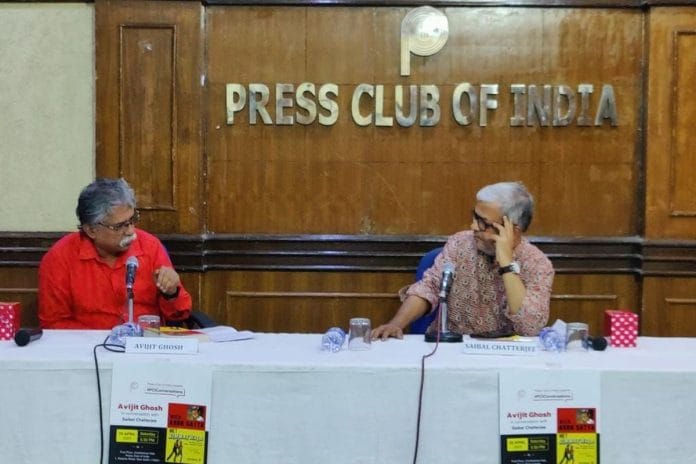New Delhi: It has become somewhat of a cliché to call the 1980s the worst decade in Bollywood cinema. But when a recent book launch event in New Delhi pitted Ardh Satya against Himmatwala, it opened a new way of viewing the decade.
“If I had a girlfriend and I asked her to go to a movie with me, she would probably have said no to Himmatwala but yes to Ardh Satya,” film critic Saibal Chatterjee said in a conversation with Avijit Ghosh, author of the new book When Ardh Satya Met Himmatwala: The Many Lives of 1980s’ Bollywood Cinema, a Speaking Tiger publication. In that decade, the divide between commercial and art house films as well as the audience was clear.
And then Ghosh dropped a truth bomb: The ’80s was the decade that saw the future.
On the breezy Sunday evening of 29 April, the small conference room of the Press Club of India at 1, Raisina Road, started to fill with cinema aficionados. Soon, extra chairs had to be brought in.
It was clear that the decade, routinely criticised for producing mediocre films, has its share of enamoured fans. The discussion exceeded the stipulated time of 30 minutes – with the attendees observing, commenting, and enquiring throughout. It was an all-you-can-buy history of ’80s Bollywood in just over an hour.
Also read:
Influenced by change, tumult
Bollywood movies of the ’80s were shaped by the multiple disruptions taking place in the country at the time. The film industry was up against era-defining changes, struggling to win back audiences. But even then, 1,594 Hindi movies released that decade, the highest until then. Ghosh said 1982 was the year colour transmission came to television with the big Asian Games event, and a massive expansion followed. The live telecast of one-day cricket matches also impacted viewing culture. Matinee shows became popular, but footfall dwindled for evening slots. Across hostels and homes, people began huddling around TV sets for entertainment.
The advent of drama serials added to the growing list of concerns for movie makers and distributors. The release of India’s first Hindi soap opera, Hum Log, in 1984 meant entertainment was no longer restricted to movies. “Directors like Shyam Benegal, Basu Chatterji and Ketan Mehta thought that the middle-class audience had shifted to television,” said Ghosh. From Yatra (1986), Kakaji Kahin (1988) to Mr. Yogi (1988), they too began making TV serials.
Chatterjee also pointed out how agitations such as the Assam movement between 1979-85, and the Gorkhaland and Khalistan movements of the ’80s, adversely affected the movie business. Cinema halls were either bombed or shows cancelled. Screenings became fewer, and the industry felt the pressure to stay afloat.
And then came the VCR revolution.
“It is VCRs that brought in individualisation of entertainment,” said Ghosh. But they also allowed piracy to thrive. “Middle class didn’t think piracy was unethical,” Ghosh added.
Also read:
The rise of ‘grade pulp’
Kader Khan’s dialogues became inseparable from 1980s films. His importance was such that he could seamlessly work with the two existing ‘rival camps’ of Manmohan Desai and Prakash Mehra, Ghosh said, and had the ability to capture the audience’s pulse.
Racy lyrics, frisky songs and memorable dialogues were the hallmark of the 1980s—and Himmatwala, written by Khan, epitomised it. The decade also saw the rise of Khan’s jugalbandi with Bappi Lahiri, who belted one hit number after another – Yaad Aa Raha Hai (1982) to Tamma Tamma (1989).
Ghosh isn’t just an apologist for the dark decade, but he is also a true, informed fan.
When an audience member mentioned the cringy cult classic, the 1998 Mithun Chakraborty-starrer Gunda — an obvious inspiration from ’80s cinema, replete with rape scenes and racy, double-meaning dialogues — Ghosh sprung a surprise again. Gunda was the best film of its kind, he said.
“We don’t study grade pulp with seriousness,” he mused.
Ghosh also mentioned how B and C-grade films were being produced one after the other, minting money despite their shoe-string budget. He shared an interesting anecdote about actor, producer and director Joginder Shelly, known for making C-grade movies. “He made a film called Adamkhor [1986] that he dedicated to then-Prime Minister Indira Gandhi.” The unexpected nugget of information elicited peals of laughter from the conference room.
Also read: Basu Chatterjee told simple, heartfelt stories that had no heroes, only people like us
Women of ’80s cinema
Was there space for strong women during the dark decade of Hindi cinema? It’s like asking, will there be singing in the dark times?
Sabiha Farhat, a journalism and media studies professor at Apeejay Stya University, said women got central roles in 1980s arthouse films when commercial cinema was obsessed with titillating rape scenes.
But Ghosh pointed out that the 1980s also belonged to Sridevi and Madhuri Dixit, two undisputed stars who could turn out commercial hits — such as Nagina (1986) and Tezaab (1988) — regardless of the male actor paired with them. Such was the seductive contradiction of the decade.
Ghosh then mentioned female ‘dacoit’ characters with agency, such as in Ramkali (1985), Seetapur ki Geeta (1987), and Daku Hasina (1987). He also called Sridevi’s ‘double role’ in Chaalbaaz (1989) – where she played a coy Anju and her bold sister Manju – as one with “principle”. Like Amitabh Bachchan, Ghosh wrote in his book, “Sridevi could make any ridiculous situation look convincing.” But despite the evolution in female portrayals, some producers kept sticking to their exploitative business practices.
He points out in his book how jawani (youth) was a word used to spice up film titles—between 1986-1989, 15 Hindi films had this word in their titles. Like rape scenes, it would also play an integral role in luring audiences to theatres.
The discussion ended with the acknowledgement that the ’80s was an intriguing decade despite being relegated to the margins. The superfans who enthusiastically participated in the discussion are proof.
(Edited by Zoya Bhatti)






